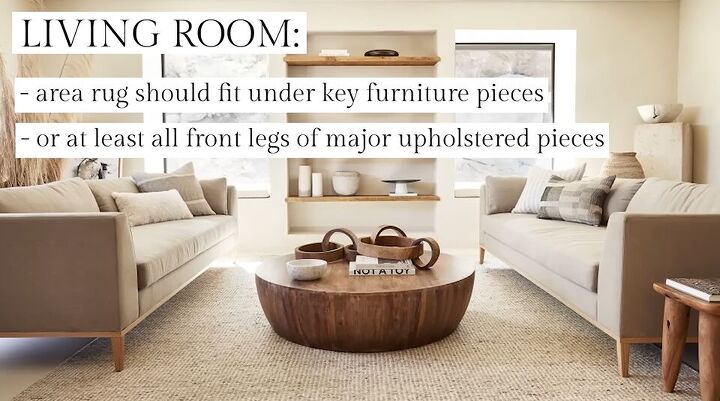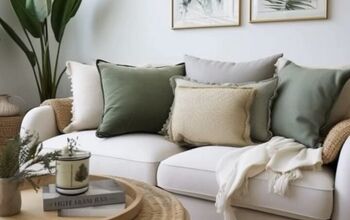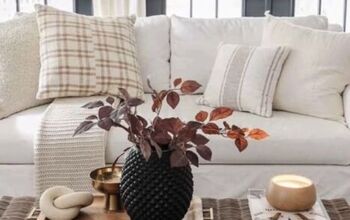7 Common Decorating Mistakes & How to Easily Fix Them

Today we're going to pull the curtains back and expose the worst decorating mistakes that actually harm your home. These 7 common decorating mistakes may not seem like much at first, but they leave your house feeling uninviting and can even make it harder to sell.
Table of contents
1. Rugs that are too small
Buying too small of a rug is one of the easiest design mistakes to make. When you're considering buying a new rug, always place all of your furniture where you want it to be and then measure for your rug.
For a living room, an area rug should fit under all of the key furniture pieces. You should be able to fit at least the front legs on the rug. Typical living room rug sizes are 8 x 10, 9 x 12, and even 10 x 14.
In the bedroom, for a queen-sized bed, the most typical size is an 8 x 10, but if your room is on the smaller side, you can use a 6 x 9 as well.
For king-size beds, the most typical rug size is 9 x 12.
For a dining room area rug, get a rug that extends at least 8 inches out from each side of your table.
If you already have too small of a rug, you can save the day by layering it on top of a larger rug. Jute rugs work great for layering because the big sizes are affordable and they match with pretty much anything you place on top.
2. Shoving furniture against walls
When you push big upholstery pieces up against the wall, it creates an empty void in the middle of the room. This doesn't look good, it isn't effective as a layout, and it makes socializing with others awkward.
Here's an example of a good before and after where this particular problem gets addressed. If you don't have enough space to create a pathway between your sofa and your wall, I recommend pulling your upholstery pieces off the wall by at least a few inches just to give it that feeling of having some breathing space.
3. Curtains that are hung wrong
Ninety-eight percent of the homes I see have their curtains hung in a way that designers would define as wrong. If your curtains are floating above the ground, they're hung wrong.
If your panels look skimpy, they're not adding to your room's look.
If your rod is hung too low, that's also wrong.
And finally, if your rod doesn't extend out enough past your window, that is also considered wrong.
Curtains are an incredibly important element of a room, so it's a shame to not get them right. Remember, when we say wrong it's not to pass judgment of any kind. It means that the curtains are not helping the room look its best.
4. Hanging “bad” art
Bad art is anything that doesn't work well with its surroundings and that you hung simply to fill a space on the wall. The best art, on the other hand, is exactly the opposite of that. It's art that looks good with its surroundings and also has some kind of significance to you.
Look at how well-integrated these art pieces are in these spaces.
Each room pulls colors from the art and the furniture.
Plus, the wall colors are in the same general color family as the art, which makes it all feel cohesive.
5. Buying furniture with crazy patterns
Think hard before you spend your hard-earned cash on a big-ticket item with a crazy pattern or a wild unusual color. A sofa is a pretty big purchase, so chances are you're probably going to want to hold on to it for a longer period of time.
I always recommend going neutral on your big upholstery pieces. Neutral is classic and elegant, and it's the perfect backdrop for playing with pattern and color on smaller, less expensive pieces that won't make you cry if you decide you don't like them anymore.
6. Not layering your lighting
Having only one light source in a room, like a light that's placed right in the center of your ceiling, is a very common design mistake. Well-designed lighting schemes include layers of different kinds of lighting, namely ambient lighting, task lighting, and accent lighting.
Ambient lighting is the general, overall light that fills the room. You get your ambient lighting from overhead light sources, sconces on the walls around your room's perimeter, or from cove lighting. Light from your windows and skylights is also considered ambient light.
Task lighting is what you use when you need to focus on something specific, like using a reading light or under-cabinet task lighting in your kitchen.
Accent lighting is about highlighting things that are already in your space, like art on the wall. As a general rule, your accent lighting should be about 3 times brighter than the surrounding ambient lighting for the best impact.
7. Picking your grout color as an afterthought
The worst thing you can do is spend weeks agonizing over what tile to pick, which pattern to lay it in, and then leave the grout color as an afterthought.
If dirty grout drives you bonkers, you may have to go to great lengths to restore the pristineness of white grout. To save yourself a headache, consider going with a gray or a beige grout instead.
Let's talk about this example. The homeowner had her tiler painstakingly lay out this beautiful white tile in a beautiful spiral pattern and then she chose a white grout that didn’t provide any contrast so the pattern completely disappeared.
Decor mistakes to avoid
Those are my top 7 decor mistakes to avoid. Not only do these home decor mistakes make you look like you don’t know what you’re doing, but they can cost you money when it’s time to sell your house.
Which of these decor mistakes tops is the worst offender in your opinion? Let me know in the comments section below.










































Comments
Join the conversation